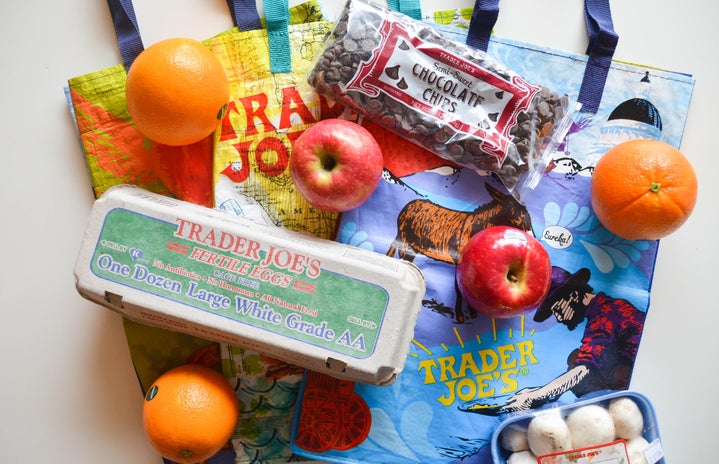Living on your own in college is life-changing enough as it is, but adding an off-campus apartment can make things even more difficult. Going from the convenience of dining halls to having to grocery shop and cook for yourself is a huge transition that is hard to adapt to. It’s easy to fall into the habit of buying groceries and wasting them or, even worse, barely eating at all. Luckily, I have had plenty of experience feeding myself, even before I started here at UConn, so here is how I eat healthy(ish) while living in my college apartment without breaking the bank.
1. Be realistic with how much food to buy
For a very long time, I would be super motivated on Sundays (my grocery shopping day) to eat super healthy and not go out to eat at all that week. However, I always end up eating out for at least two to three meals, which leads to food getting wasted and me feeling bad about myself. A good way to combat this is to be really honest with yourself about how often you are going to eat out and incorporate that into your grocery plans. Whether you are just trying to save money or are on a fitness journey, you are allowed to eat out every once in a while if that is something you enjoy, so do not deprive yourself of that! Just make sure to be realistic with how often you will go out so there are no surprises down the road.
2. Make a list of Meals You Want to Eat
Once you have calculated exactly how many meals you need, start thinking about what exactly you want to eat. This will of course vary from person to person, depending on your cooking ability, amount of time, and the foods that you enjoy. I personally eat the same exact breakfast every single day, so I plan to make seven of those, but if you want to do more than one breakfast you can always add in another one or two. I then pick anywhere from three to five other meals that can be used for lunch and dinner. Try to pick meals that have some of the same ingredients, so you can buy less food and waste less, which is good for your wallet and the planet.
3. Create Your Grocery List
Now that you have your meals, go through and see exactly which ingredients you need for each meal. Include absolutely everything, from seasoning to produce to cooking oil. After the list is made, you can go through and remove any staple ingredients that you already have. As you start to cook more, you will find that you need fewer and fewer staple ingredients since you had already bought them at one point, which makes the cost burden a bit lower after a few weeks. Calculate the amounts of meat and produce you will need if applicable to avoid buying too much or too little. I always like to use the Instacart app, or the grocery store’s app if they have one, to put together my list because I can also see the prices which helps me stick to my budget.
4. Order Your Groceries Online
I know I’m not the only one who goes to the grocery store with a list of items but then ends up spending at least $50 more on random snacks and other things that I find while walking around. If this is you, I would recommend ordering your groceries online for pickup, or delivery if you are willing to shell out the extra money. By pre-ordering your groceries, you are making it impossible to add on extra items you don’t really need. I personally do most of my shopping at Aldi, so I will order for pickup through their website which saves me not only money but time as well. This rule is unfortunately not applicable if you go to Trader Joe’s, in which you’re bound to spend double your budget because 1. You can’t pre-order and 2. There are so many fun items to choose from.
5. Be Wise About Your Meal Prep
Now that you have your groceries, unless you have the time and desire to cook two meals every day, you’ll probably want to meal prep. But the problem a lot of people have with meal prep is that they don’t want to eat the same food for five to seven days in a row, nor do they want to eat food that has been sitting in the fridge for multiple days. This is a totally valid concern. To solve this problem I have two bits of advice: the first is to meal prep twice a week if you have the time so that the food is consumed within three to four days; I personally meal prep on Sundays and Wednesdays. Another tip is to prep ingredients, not meals. For example: if you are incorporating chicken and roasted veggies into your meals, cook just the chicken and just the veggies and put them in separate containers. That way when it is time to make a meal, all you have to do is combine the ingredients and then add seasoning or sauce and you’re done! This way food also does not get soggy by having a bunch of sauce and other things on it. Both of these tips are great ways to keep food fresh and have a good variety in your meals.
6. Get Creative and Have Fun!
Cooking at home doesn’t mean you have to eat boring food. There are plenty of delicious recipes out there that are still healthy and less expensive than takeout; you can also take your favorite meals and swap out ingredients/methods of cooking for more healthy options. It took me a long time to realize that I could still eat pizza, pastries, etc., and still reach my goals. I get lots of food inspiration from social media influencers; for example, one of my go-to influencers for recipes is @fitfoodieliving on Instagram, also @livcarbonero on TikTok. She posts absolutely delicious meals that make me feel like I am eating takeout when in reality I’m eating a much healthier and less expensive option. I’ve linked my favorite recipe of hers, the spicy McChicken, which I eat at least twice a week. There are countless other people on the internet doing the same thing, so find some recipes you like and remember eating healthy and cheap does not have to be miserable.
To sum it Up
Feeding yourself is already stressful enough in college with how busy we are, and having to grocery shop and cook can make it even more stressful. But if you follow these tips, you will find that not only is grocery shopping not as hard as you may think, but you might also find a new hobby in cooking.


